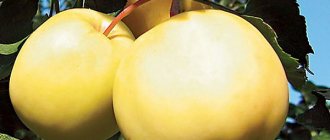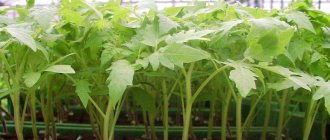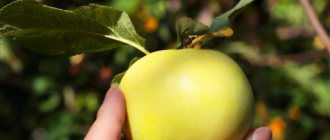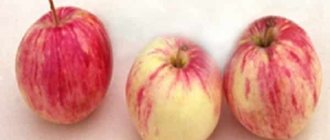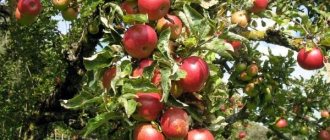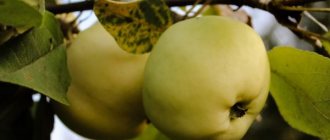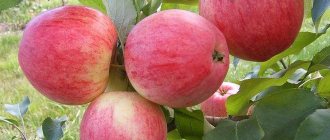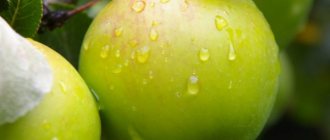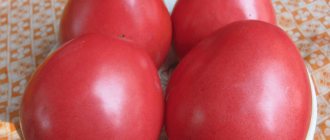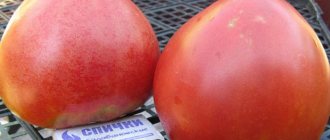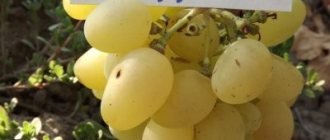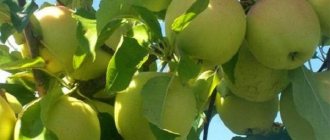The Spartan apple tree variety is an excellent representative of winter varieties with a long shelf life of delicious, beautiful apples. Unfortunately, Spartan does not have high winter hardiness, as a result of which its cultivation is limited to regions with a relatively mild climate. But where it does well, this variety is highly popular among gardeners.
- 2 Planting a Spartan apple tree: step-by-step instructions
- 3 Features of cultivation and subtleties of care
- 4 Diseases and pests: main types and solutions to the problem
- 5 Reviews about the variety
Description of the variety
The Spartan apple tree is high-yielding and fast-growing. The tree begins to bear fruit in the third year, but produces the maximum amount of fruit after 8 years. Technical maturity occurs in September, and consumer maturity – after two months if properly stored.
The tree is medium-sized, with a wide spreading crown. It requires formation because it can become overgrown. The leaves are dark, glossy, leathery and slightly curved. Flowering is lush and abundant, Spartan is an excellent pollinator for many apple trees.
The fruits are flat or slightly rounded, medium in size. Their hue is green-red, during storage they become burgundy, and the coating makes the hue darker, even purple. The taste of the firm pulp is sweet and rich. The taste is quite unusual, a sort of mixture of notes of sweetness of melon and fresh sourness of strawberries. The description of Spartan apples does not end there.
Harvesting Antonovka apples for storage
Antonovka is again gaining popularity among gardeners. Every year more and more lovers plant it in their garden plots. However, subsequently a person faces the question: when to collect Antonovka apples for storage? This variety has consumer and removable readiness. The first occurs when the fruit has become softer, and occurs around the end of October. But regarding removable readiness, we can say that it is ahead of consumer readiness by almost a month. This period falls at the end of September. The fruits at this time are distinguished by the appearance of a characteristic yellowish color. However, you don’t have to wait until the fruit turns completely yellow: this can lead to poor shelf life and over-ripeness.
It is best to collect Antonovka in the morning, when the dew has disappeared. For harvesting, you need to choose dry weather, avoiding dampness on the fruits before placing them in the box. Collection begins from the lowest branches and gradually moves upward. Those apples that fall off on their own during picking should not be placed in a common storage box: they may be damaged and have much worse shelf life.
Characteristic
The Spartan apple tree has some features that need to be considered before deciding whether to plant it on your site. Wood has a lot of positive properties, but it also has a number of disadvantages.
Appearance
The appearance of the apple tree is quite attractive. The fruit tree is of medium height and has a rounded crown. The inclined branches are completely covered with beautiful fruits of an unusual violet-gray hue.
Leaf color and shape
The leaves are small and many are very small. Their surface is wrinkled, leathery, the leaf itself is slightly curved, glossy. They are wide, rounded, with serrated edges.
Spartan apples on the tree.
Tree height
An average height apple tree can reach 6 m. But the standard size is 4-5 meters. However, depending on the rootstock and if properly shaped, the height of the tree may be lower.
Crown width
The crown is quite lush. The branches that are located downwards in large numbers only make it even thicker.
Disadvantages and advantages
The variety gained popularity due to a large number of positive properties. Particularly worth noting:
- high productivity;
- regularity and abundance of fruiting;
- excellent taste;
- long shelf life of fruits and the possibility of transportation;
- immunity to many diseases.
But there are also negative properties that should also be taken into account. One of them, and a very important one, is the instability of the Spartan apple tree to low temperatures. It cannot grow in the harsh Northern regions, and in normal temperate climates it requires shelter.
The tree has many branches that grow quite quickly. Therefore, pruning should be a regular and mandatory procedure. Some gardeners note this as a drawback.
Tasting assessment
The taste of the fruit is very high. Their taste is almost perfectly sweet, with light sourness and wonderful fruit and berry notes of melon and strawberries. For such a bright bouquet, Spartan received an organoleptic rating of 5 points. And this is the highest result!
Fruits of the Spartan apple tree.
In addition to taste, there is also a rich composition. The fruits are very useful. They contain many vitamins, including ascorbic acid, minerals and trace elements.
Frost resistance
The apple tree does not like severe frosts; spring frosts and sharp autumn cold snaps can be destructive for it. Therefore, Spartan is not grown in northern latitudes, but requires shelter in others.
Self-fertility
The variety is self-fertile and does not need the company of other apple trees in the garden. But the flowering is so gorgeous and abundant that it not only attracts the eye, but also attracts many insects. Spartan is an excellent pollinator for other apple trees that bloom at the same time.
Apple tree
My family owns a small farm where we grow and then sell environmentally friendly and organic products. One of the very popular products is Spartan apples. The fact is that the fruits are very beautiful - they have such a red-violet hue and are stored well without preservatives.
They are always quickly taken apart, so I decided to share with you the main nuances of growing a Spartan apple tree at home.
This variety is relatively young - it was bred in Canada about 50 years ago, so there is less information about it than about earlier varieties. But these apple trees are very productive, and the fruits are famous for their taste, so I still recommend that even experienced gardeners who have previously grown traditional varieties pay their attention to them.
Origin
"Spartan" is a winter, early-fruiting variety. It was developed in the twentieth century at one of the Summerland experimental stations in Canada. It is not known exactly which varieties were selected for selection, but it is suspected that they were Mekintosh and Pepin Newtown Yellow. But for cultivation this does not matter much.
In their homeland, Canada, these apples spread very quickly and became very popular. The fame of new apples, which were not only tasty, but also very beautiful, quickly spread throughout the world - literally within a few years they began to be planted almost everywhere.
It turned out that “Spartan” does not take root well in cold countries - the trees did not tolerate frost well. But in more southern regions, apple trees grew well and produced a large harvest.
Main characteristics and features
The variety is characterized by very rapid growth and development, so it constantly needs care.
- Apple trees are usually of medium height, with a rounded crown. The annual shoot is dark brown or cherry in color. There are no lateral branches.
- The leaves are small, their base is heart-shaped, and the tips are always curled. The color is often dark, almost emerald green, and the tree blooms profusely and beautifully.
- The fruits are often grown for sale - if stored correctly, apples can be stored without any preservatives until April of the following year. Also, the fruits tolerate transportation well and do not lose their appearance.
- Even the youngest tree produces an excellent harvest - about 15 kilograms of apples. Mature apples are very productive - 100 kilograms of apples can be harvested from one tree.
- The variety is very fast-growing - in good conditions and with proper care, the first abundant harvest can be harvested within three to five years after planting.
- Very resistant to the most popular apple pests - scab and powdery mildew.
- Unfortunately, the variety is not without its drawbacks. The main one is low frost resistance. In a region with cold winters, growing “Spartan” is quite difficult, even if you care for and protect the tree in winter.
- Over time, the apples become smaller. The process can be slowed down by constantly trimming the tree, but it cannot be stopped completely.
Fruit
The main advantage of the variety is the apples themselves. The fruits are very beautiful - unripe fruits are light yellow, ripe ones are dark red, with a blue or purple tint.
The average weight of one fruit is 150 grams; large ones grow rarely. The shape is most often round, sometimes it can be slightly ribbed or conical. The flesh itself is white, crispy and juicy; there may be reddish veins. The aroma is bright, apple, intensifies as the fruit ripens.
The fruit contains a lot of fiber, which helps improve functioning and cleanse the intestines, and pectin is very good for the skin - improves its tone. It also contains a lot of ascorbic acid - it perfectly protects against infections and strengthens the immune system.
If you have problems with the cardiovascular or digestive system, then regularly eating “Spartan” apples will be an excellent choice.
However, people who suffer from gastritis or ulcers should eat Spartan with caution - in large doses they can provoke an exacerbation.
Reproduction and planting
It is best to plant an apple tree in spring or autumn. The most popular and convenient way to plant an apple tree is with seedlings, ideally about two years old. An even simpler option is young trees about five years old, which immediately begin to bear fruit. For planting, you need to choose a suitable place - sunny and open to drafts.
- First you need to dig a hole. The depth is approximately 60 centimeters, the diameter is about a meter.
- You can put a layer of soil with any complex of mineral fertilizers on the bottom - this way the tree will take root better.
- We plant the apple tree in a hole, and be sure to tie the tree to a peg.
- The seedling must be pruned immediately after planting - this will stimulate tree growth.
- We create a “roller” of earth around the hole - this is a circle for watering.
- Now the tree needs to be watered - pour water until it stops being absorbed.
Care
“Spartan” in general is a rather unpretentious variety and does not require intensive care. If you follow a number of simple rules, the tree will be healthy and productive.
Watering
It is best to water the apple tree once a week - it is recommended to do this in the evening. At the same time, it is worth sprinkling - that is, spraying the crown with water. This is an excellent prevention of diseases and pests, and the tree will be saturated with moisture even in the heat.
Top dressing
Feeding "Spartan" is carried out three times during the harvest season:
- The first stage is carried out as soon as the snow melts, usually in April. About half a kilogram of urea and five buckets of humus should be added to the tree trunk circle around the tree.
- The second stage is at the very beginning of flowering. You need to mix humus, slurry and bird droppings - about four buckets of this mixture need to be made for one tree.
- The third stage is carried out after flowering and harvesting. For 10 liters of water you need to take half a kilogram of nitrophoska, 10 grams of dry sodium humate. Water each tree with three buckets of this solution.
Trimming
Pruning is the most important part of caring for a Spartan apple tree. The fact is that the branches of the plant grow very quickly - and this can lead to loss of yield. There are two different types of pruning when caring for an apple tree:
- Sanitation is a procedure that is carried out for almost all trees. It involves pruning branches that have already dried out or have been damaged mechanically or by disease. It is done as needed - often the crown needs to be corrected after winter, often after harvesting.
- Another type of pruning for the Spartan apple tree is differentiated. With this method, it is not always the case that only diseased branches are pruned—sometimes it is necessary to remove healthy ones as well. The essence of such detailed pruning is to shorten overgrowing and semi-skeletal branches. The fact is that the crown of “Spartan” itself is prone to strong thickening, and this does not have a very good effect on the quality of the fruit.
Victor
Spartan are excellent apples, I planted several trees about 20 years ago and have been happy with them ever since. Very productive, the fruits are beautiful and appetizing in appearance - well suited for sale if this is what you do.
Apples are tasty, but the trees require constant care - if you simply forget about them for a year, the harvest will be much smaller. Overall, the variety is excellent, it’s not for nothing that they love it so much.
Marina
I grew up in the southern region, we had a whole garden of Spartan apple trees. They really are very tasty and store well, so when we moved, I immediately decided to plant them in a new place. The problem is that the new place has a very cold climate.
The trees took root with great difficulty and after a couple of winters withered away, although I took care of them as best I could - insulated them and wrapped them up. So if you live in an area with cold winters, it is better not to choose this variety.
Source: https://sornyakov.net/trees/yablonya-spartan.html
Reviews
Ekaterina Nikolaevna, Kursk: “I heard a lot of good things about the apple tree, but they also said other things. I was afraid that it wouldn’t take root here, because it gets quite cold here in the winter. But a wonderful apple tree has grown and produces a lot of fruits that have an interesting taste. The photo shows Spartan in bloom. I’m happy, however, my husband swears that I need to trim a lot and twice a year. But these minor difficulties do not upset me.”
Fedor, Ukraine: “I am an amateur gardener, I don’t have much experience. I bought Spartan apple tree seedlings at the market and listened to the seller. Excellent apple tree, I am very pleased. No worries or hassle. And what delicious apples!”
Vika: “This tree grows in our house, my mother takes care of it all the time. But I just love to eat delicious and beautiful Spartan apples in winter.”
Features of planting and care
Although planting and care activities are not particularly difficult, there are some subtleties that you should know.
Landing
It is necessary to plant a young plant in an area with fertile soil. The place should be well lit, it is better that there is protection from strong winds. It is important that groundwater is not located close to the site.
Planting a Spartan apple tree.
Deadlines
If an apple tree seedling is planted in the spring, this usually happens at the end of April. The exact date depends on the climatic conditions of the region. Autumn planting occurs in September-October.
Landing technology
Almost all apple tree planting technology is similar to the standard procedure:
- Prepare a planting hole measuring 50*100 cm in advance. Drainage must be poured into the bottom and fertilizer must be added.
- The seedling is installed and the roots are carefully straightened in the hole.
- Cover with fertile soil, water and mulch.
It is important to choose the right fertilizer for the soil type. If necessary, add sand, ash or peat.
Distance between trees
Spartan prefers to stay at a sufficient distance from other fruit crops: at least 4.5-5 meters. But if there are several trees of this variety on the site, then you can slightly squeeze them out and place them at a distance of 3 m from one another.
Features of cultivation
There are several nuances that need to be taken into account when planting. Among them:
- the plant is quite sensitive to dry air. Therefore, in the hot season, sprinkling on the leaves and regular watering will be required;
- in order to saturate the roots with oxygen, you need to loosen the tree trunk circle, but do this carefully so as not to damage the roots;
- the fast-growing crown needs timely pruning so that the fruits receive enough sunlight and air circulates well among the branches.
If these procedures are carried out in a timely manner, the tree’s immunity will be strengthened and it will be healthy.
Watering an apple tree of the Spartan variety.
Pollinator varieties
The apple tree carries out more than 2/3 of pollination on its own. But if there are other varieties nearby, then the number of fruits will only increase. A useful neighborhood will be from McIntosh, Idared, Jonathan, Golden Delicious. Other apple trees will also benefit from this proximity.
Pruning and crown formation
Pruning is extremely important for representatives of the variety. But you need to do it correctly. Usually, only weak and crooked shoots are cut off, and those with the correct shape are left.
Canadian agricultural technology
The apple tree comes from Canada, and therefore it is worth considering the growing technology adopted at home. Surprisingly, in its homeland it is grown in a dwarf form and is absolutely not pruned. The apple tree is practically not watered and nitrogen is not added so that the vegetative parts do not grow in excess.
Among the agrotechnical measures in the homeland of Spartan, only fertilizing, regular careful loosening and monitoring of the condition of the tree are carried out to avoid the appearance of pests.
How to store and pack?
Long-term storage of apples is possible only when the temperature is low enough - 2–5°C. The humidity in the room matters; it should be between 85–90%. In a dry microclimate, fruits quickly wither and wrinkle.
Containers with wet sand will help avoid this. If a basement is used for storage, it must be prepared. Clean up, whitewash the walls with a solution of lime and copper sulfate. Disinfection will get rid of bacteria and fungi that threaten the condition of the apples.
There are several ways to stack apples:
each fruit is wrapped in paper and placed with the stalk facing up; it can be placed in several layers;
- apples are sprinkled with sand or clean sawdust, they should not touch each other, they are placed in a box in 3-4 layers;
- in hermetically sealed plastic bags, apples are poured into 5–7 kg, stored in the basement or in a hole outside, covered with earth.
The places where apples can be stored can be the following: pantry, balcony, basement, refrigerator.
Important! Apples should not be stored next to other fruits and vegetables. They emit ethylene, which is harmful to food.
During the winter, the fruits are regularly inspected , and rotten apples are removed.
How to preserve apples in winter:
Features of ripening and fruiting
There are also nuances and features that gardeners need to consider before planting an apple tree.
Beginning of fruiting
The first fruits on an apple tree can appear already in the third year, because it is quite early-bearing. But a plentiful and maximum harvest can only be harvested after 8-10 years.
Bloom
The flowers open in May, usually within a week of each other depending on weather conditions. Flowering is abundant, long lasting, with a persistent aroma.
Flowers of the Spartan apple tree.
Harvest time
Apples should be harvested at technical ripeness in September and even before mid-October. Ripening is friendly and plentiful, the fruits do not fall off.
Ripening time
Consumer maturity comes much later. Moreover, the longer the fruit is stored, the richer its taste. Some gardeners leave a few fruits on the tree until frost to enjoy delicious apples.
Features of fruiting
It should be borne in mind that the quality of the fruit directly depends on agricultural practices. If the crown is too thick, the fruit becomes smaller.
Typically, cyclicity is not observed in fruiting. But if the tree is exposed to low temperatures, the number of apples will decrease significantly. Cycling can also occur due to lack of fertilizer.
Why doesn't it bear fruit?
It happens that an apple tree blooms profusely, but does not bear fruit. There are several reasons for this:
- The time has not yet come, the tree is quite young;
- pests that eat flowers;
- The apple tree suffered from frost.
If this did not happen, then perhaps the tree has already passed the fruiting age.
Shelf life
A special feature of Spartan apples is their long shelf life. Under the right temperature and moisture conditions, apples can be stored for about 7-8 months. During this period, the taste only becomes richer and more pleasant. Moreover, by the end of the storage period in the cellar, apples may lose a little appearance, but in the refrigerator they look perfect.
Spartan apple harvest.
Spartan apples: how to ensure proper tree care?
Modern dietetics pays special attention to wonderful fruits - apples, which occupy a significant part in the menu for various purposes.
Spartan apples are one of the most popular fruits for fasting diets. Apples have always been a desirable dessert on the table of princes and peasants, but several decades ago they became the main vitamin product in childhood, during the restoration of the body, for athletes and people working under conditions of increased physical activity. Thanks to the work of breeders around the world, today more than 60 hybrid varieties are cultivated in various climatic zones of the world, among which Spartan occupies a special place.
Description of the variety Spartan
Thanks to the work of Canadian breeders in the first decades of the last century, one of the most popular varieties today appeared in our gardens - “Spartan”, a hybrid of American McIntosh and Yellow Newtown apple trees. Today it is considered a real veteran of domestic horticulture, one of the first foreign varieties released in the Soviet Union, in particular in Ukraine.
Today it is successfully grown in the northern and northeastern regions of the country.
The main characteristics of the variety, allowing even inexperienced gardeners to recognize it among others:
- Compact characteristic crown of spherical shape, fruits in the form of clusters are located in ringlets, shoots are dark cherry in color, strongly drooping, leaves are dense, leathery, deep green
- The fruit is small in size, round, with a ribbed apex. The surface color is yellow with pronounced crimson or bright pink spots
- The surface of the apple is covered with a significant layer of natural wax, which gives it an almost purple hue and makes it ideal for storage and transportation.
When choosing a variety of Spartan apples, gardeners pay special attention to the characteristics of the pulp. It has a wonderful white color, high density and pleasant taste.
The combination of sweetness with a pleasant, fairly strong aroma creates a unique charm and makes the variety attractive to buyers.
The chemical indicators of the fruit are as follows: sugar at least 10.6%, acids up to 0.32%, vitamins of group “C” about 4.75 mg/100g.
Advantages of the variety
In order to fully characterize the variety, the many benefits of the widely cultivated tree should be studied:
- Fruiting of Spartan begins in the third or fourth year, very rarely in the fifth, it belongs to early-bearing varieties
- Flowering is early, abundant, friendly, pollination occurs easily, even in cool spring
- The fruits have excellent taste and contain a large amount of vitamins, in particular ascorbic acid.
- The variety is distinguished by high yields, which are unstable under unfavorable weather conditions. Up to 10 years – from 15 to 35 kg, from 12 to 15 years – up to 75 kg
- Spartan apples are distinguished by their high transportability and shelf life without loss of quality from five to seven months. In spring they are quite high quality and tasty
The variety has high immunity to scab and other diseases. In addition to numerous advantages, Spartan has some disadvantages. This is insufficient resistance to frost and prolonged precipitation. The older the tree, the smaller the fruits become with each harvest. To maintain a stable yield level, proper annual pruning of trees is required.
Features of cultivation and where they grow
Spartan trees love abundant sunlight; planting in a well-selected and prepared site on a hill allows for stable harvests. The best months for planting would be mid-April or the first days of September. Features of cultivation:
- The hole for planting should not be deep - up to 0.6 m, stones are placed at the bottom as drainage, filled with compost, a composition that includes 250 g of superphosphate, 100 g of ash and universal fertilizers for fruit trees
- Fill with water to dissolve and soak the mineral salts. After planting, re-watering is carried out for a week, in the evening.
- Four feedings are carried out throughout the year - in mid-April, during the flowering period, in June, and after harvesting the fruits in September.
This variety has high requirements for systematic pruning. The crown is formed in such a way as to ensure the growth of trees and strengthen the remaining branches.
To prevent fruit rot, codling moth and cytosporosis, spraying with solutions of Skor, Horus, Fundazol, and Tsimbus is used.
Originally in Spartan’s homeland, in Canada the variety is used for commercial cultivation; in our latitudes it is cultivated for consumer purposes.
In addition to the northern and eastern regions of Ukraine, farmers and gardeners in central Russia and Belarusian Polesie receive good harvests. Thanks to its resistance to diseases and generous yields, Spartan has become one of the most popular crops in gardening farms and in amateur gardens.
Picking time for Spartan apples
The readiness of fruits for harvesting is determined in the most proven way. Pressing your finger on the side of the apple should leave a slight indentation. If it is missing, then it is too early to harvest. This variety is most preferable for storing apples for a long time. They are collected in the last days of September; it is best to choose a cool, dry, sunny morning.
It is important to avoid moisture, which reduces the quality and shelf life. By following all the basic principles of growing, collecting and storing Spartan apples, they will delight you all winter and more than half of spring with their unique taste, amazing aroma and wonderful appearance. They will decorate any, even the most formal table.
on preparing seedlings for planting:
Source: https://OgorodSadovod.com/entry/3346-yabloki-sorta-spartan-kak-obespechit-pravilnyi-ukhod-za-derevom
Subspecies and options
There are several possible options for growing Spartan apple trees. Descriptions of these methods are below.
Rootstocks
Choosing the rootstock on which the variety will be grown is an important and responsible matter. This may change some characteristics of the variety.
Dwarf
Grafting onto a dwarf rootstock, usually Budagovsky's red-leaved paradise, will give the variety several properties:
- The growth of the apple tree will reach 2 meters, no more.
- The fruits will appear in the third year.
- The root system will be frost resistant.
- The standard will need to be insulated; it may freeze.
But the size of the fruits will be much larger than with conventional cultivation, but only if there is a sufficient amount of fertilizer.
Semi-dwarf
The variety is most common on a semi-dwarf rootstock in Ukraine and some parts of Russia. This type has a number of positive properties:
- the apple tree becomes more resilient, tolerates drought and frost;
- tree height reaches 3.5 meters;
- The first fruits are harvested 4 years after planting.
Frost resistance and drought resistance make this variety more adaptable and in demand.
Columnar
Despite the convenience of growing columnar apple trees, Spartan is not yet grown this way. Although this would be much more convenient, because columnar plantings are often winter-hardy.
Apple tree Spartan on a columnar rootstock.
Varieties
The timing of growing the Spartan apple tree variety also differs.
Late
The late variety is more productive, but the fruits are stored a little shorter. This does not change the commercial qualities, as well as the taste.
But late cultivation has a positive effect on the tree itself. It acquires frost-resistant properties and immunity to fungal diseases.
Winter
Since the tree is not resistant to low temperatures, it is practically not grown as a winter tree. But with proper preparation this is possible. Then the fruits can be harvested in October, but the apples will be smaller.
Diseases and pests
The Spartan apple tree is characterized by the same diseases and pests as many other varieties. Thanks to the efforts of Canadian specialists, this variety has acquired some resistance to scab and powdery mildew. But you shouldn’t discount them either, because they can appear under particularly favorable conditions (high humidity, thickened crown).
Scab is a fairly common disease that manifests itself in the form of black dots on apples. If the disease is in the initial stage, there are few such points and the taste of the fruit does not suffer, but if there is an oversight on the part of the gardener, the picture can change for the worse. Fortunately, there are plenty of methods to combat this disease, and one of them is the use of fungicides such as “Horus” (2 g per 10 liters of water - 10 liters per 100 sq. m.) or “Skora” (3–3.5 ml per 10 liters of water, 2–5 liters are consumed per tree depending on its age).
Powdery mildew is a white coating that at first looks like white fluff and is easily erased, and then becomes coarser and turns brown. The leaves dry out under the influence of the disease, and the fruits become covered with dots. The use of the drug "Topaz" allows you to get rid of the disease. It is used before and after flowering - 2 ml of the drug is used for 10 liters, 5 liters of solution are used for one apple tree.
Fruit rot, or moniliosis, primarily damages the fruits. They rot and become covered with beige dots - these are spores of the fungus that causes the disease. They get rid of the problem with the help of “Skor” and “Horus”, already known to us, as well as “Fundazol” (add 10 g of the product to 10 liters of water, 2 liters of solution will be needed for a young apple tree, up to 5 liters for an adult).
Cytosporosis is another fungal disease. Spots appear on the bark, and it begins to dry out and fall off. The best means in the fight against cytosporosis are the preparations “Hom” (40 g per 10 liters, 2–5 liters of solution is needed per apple tree) and “Fundazol”.
Photo gallery: apple tree diseases
Fruit rot on apple fruits
Cytosporosis on apple bark
Scab on a ripening apple
Powdery mildew on an apple tree leaf
Among the pests, green apple aphids and codling moths become frequent unwanted guests in gardens. The first sucks all the juices from the plant and depletes it, gradually leading to death, and the second eats apples, significantly spoiling the future harvest. They need to be dealt with immediately after detection, or even better, preventive treatment of the tree with the help of appropriate preparations.
The green apple aphid is dangerous because in warm latitudes (and, as we remember, they are preferable for the Spartan apple tree) it can produce up to 16 generations per season. In small quantities it does not pose a particular threat, but in case of mass infection it will drink all the juice from the apple tree and deprive not only the harvest, but also the tree. To get rid of overwintering aphid eggs, use Nitrafen (200 g per 10 l), which is used to treat not only the tree, but also the ground underneath it. Instead, you can use green oil concentrate (GOC): 600–800 g per 10 liters of water. In summer, tobacco infusion is used: 400 g of tobacco dust is added to 10 liters of water, left for 1 day, stirring occasionally, then filtered and 40 g of soap are added.
The codling moth is not so numerous, but even in small quantities it causes harm to the gardener, gnawing holes in ripening apples. One larva can damage three fruits, which, after its visit, do not ripen and fall prematurely. To combat it, use 80% chlorophos, diluting 20 g in 10 liters of water. To reduce the number of caterpillars, catching belts are used and fallen apples are collected in time, and butterflies are disposed of using light and electric traps and bait in the form of an odorous liquid.
Features of cultivation in different regions
There are some nuances when growing in different regions.
In outskirts of Moscow
The Moscow region is characterized by fairly severe and prolonged frosts. Therefore, it is best to grow Spartan here on a semi-dwarf rootstock.
It is important to fill the hole well when planting so that the seedling has something to feed on for the first year. Fertilizers and watering will be the key to the health of the apple tree.
In Siberia
Siberian frosts are not to the liking of many resistant varieties, and especially Spartan. Dwarf rootstocks that are grafted onto wild varieties or stale forms sometimes take root in this region. It will be necessary to carefully monitor the condition of the tree and follow all principles of agricultural technology.
Growing Spartan apple trees in Siberia.
In Belarus
The country's climate makes it possible to grow many different apple trees. But it should be borne in mind that in summer there is quite high humidity. Therefore, various fungal diseases can occur on the plant. When grown in Belarus, additional protection will be required.
In the Urals
Here the climate is close to Siberian, so growing is quite problematic. But with proper shelter, the apple tree can survive in cold conditions.
In the middle lane
The middle zone is characterized by low temperatures in winter. Therefore, it is better to grow a late variety here.
In North-West Russia
The winter variety of the Spartan variety takes root in the North-West. But here the apple tree is grown only in the stale form to protect it from the cold.
In Ukraine
The Ukrainian climate is excellent for the semi-dwarf variety. It has long been popular and widespread here.
Advantages and disadvantages
I would like to once again note the positive and negative properties of the apple tree:
- With proper care, the apple tree produces a lot of tasty fruits.
- The taste of apples is simply amazing, and they are also healthy.
- Fruits can be transported over long distances and stored for a long time.
Late apple variety Spartan.
In cold regions, the Spartan variety does not take root well. The tree will need to be covered or properly shaped to make it comfortable in cold conditions.
The fruits may become smaller if the apple tree has not been shaped and pruned correctly. And if the fruit crop is exposed to low temperatures, then the number of fruits will decrease significantly.
